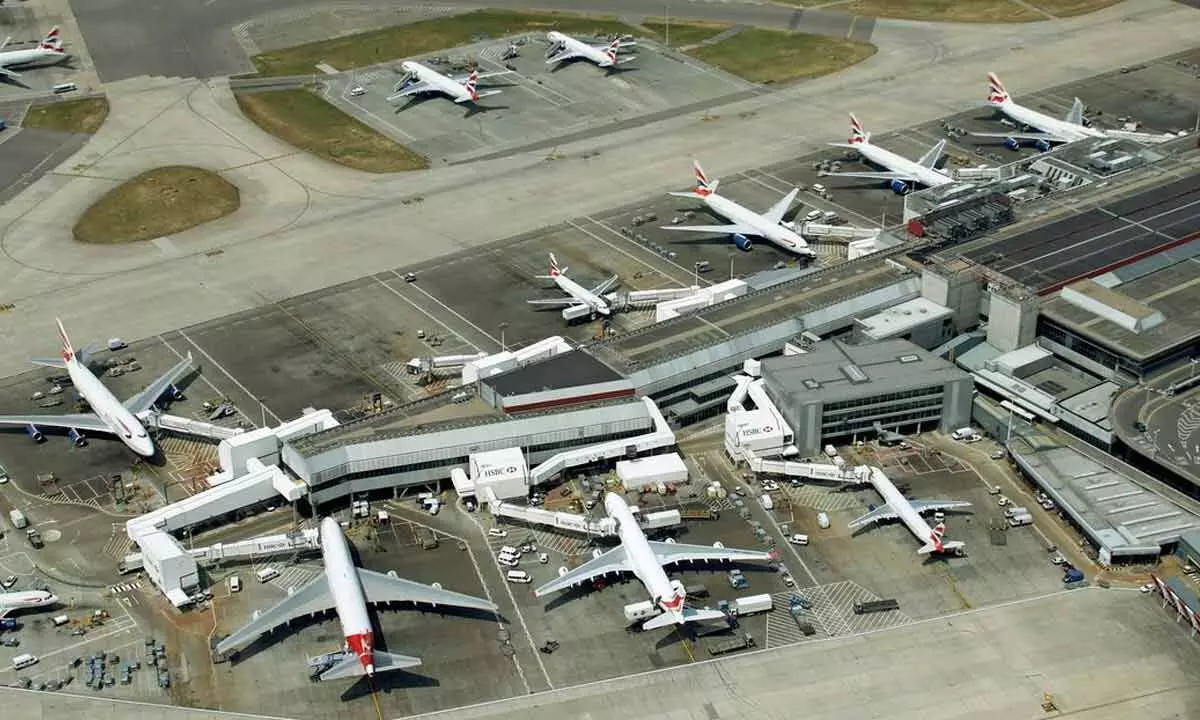Live
- They always want me to win, and now I feel lucky to have been offered a story like ‘Zebra’: Satyadev Kancharana
- ‘Democracy first, humanity first’: PM Modi in Guyana's parliament on two countries' similarities
- PKL Season 11: Telugu Titans register third straight win to top standings
- Is Pollution Contributing to Your COPD?
- NASA Unveils Underwater Robots for Exploring Jupiter's Moons
- Additional Central forces arrive in violence-hit Manipur
- AR Rahman and Saira Banu’s Divorce: Legal Insights into Common Issues in Bollywood Marriages
- 82.7 pc work completed in HPCL Rajasthan Refinery area: official
- Curfew relaxation extended in 5 Manipur districts on Friday
- Tab scam prompts Bengal govt to adopt caution over fund disbursement
Just In
Airlines mull global aviation hubs


Airlines mull global aviation hubs
An airline hub or hub airport is the name given to the airports that airlines use outside their headquarters.
An airline hub or hub airport is the name given to the airports that airlines use outside their headquarters. The hub is also used as a term that expresses the connectivity of an airport to the other airports. The more places an airport provides access, the higher the flight frequency is and the greater the hub. Today, just like the airlines, airports are also competing among themselves. That's why they increase the number of connections and compete to become a better hub.
The hub term refers to the location of the transfers in the transportation industry. In other words, passengers and cargo can be transferred from plane to metro, metro to bus, bus to train through the help of hubs.The airline hub is an airport of second-degree importance in air transportation except for the epicenters. The world's largest airports are also defined as mega hubs. London Heathrow Airport is at the top of the list as of 2018, according to reports by OAG.
In the aviation industry, airports are classified according to hub types. American model hubs connect medium-haul flights to medium-haul flights. This is due to the great size of the United States, as the flight time between two distant states can reach 6.5 hours. Moreover, with a passenger potential of more than 700 million passengers per year, the US aviation industry has the most air traffic in the world. In the European hub type, medium-haul flights are combined with long-haul flights. This type comes to life when you want to fly from a place that is not very central. For example, if you want to fly from Mardin to Delhi, you will fly to Istanbul first and then transfer to Delhi, and this is called the European model hub airport type. The last type is the Persian Gulf and Asian hub airport type. In this model, long-haul flights are also connected by long-haul flights.
The purpose of the hub-and-spoke system is to save airlines money and give passengers better routes to destinations. Airplanes are an airline's most valuable commodity, and every flight has certain set costs. Each seat on the plane represents a portion of the total flight cost. For each seat that is filled by a passenger, an airline lowers its break-even price, which is the seat price at which an airline stops losing money and begins to show a profit on the flight.
Airlines and airports are trying to make Indian cities into hubs so that flyers from across the country can first fly to these hubs and then connect onwards to international destinations. This has been made abundantly clear by the two new expatriate chief executive officers at IndiGo and Air India. Both have said that while they are not losing sight of the domestic market, they are also focusing on international traffic to and from India. The absence of a large and successful home carrier, with an appropriate network and business model, has undoubtedly been a key reason that India has failed to leverage the strength of its market, and its strategically favourable location, to develop global hubs. However, Air India's announcement last week of a record order for 470 aircraft (plus 370 options), including 70 widebody aircraft, will provide a much-needed boost to long and ultra-long haul connectivity. CAPA India expects that Indian carriers will place orders for a further 1000-1200 aircraft over the next 24+ months.
The fact that sales tax on domestic ATF remains at 25 per cent in Delhi is a clear indication that the vital role that aviation can play in economic development is not taken seriously. According to aviation associations and government officials, fuel price rise has contributed to a decline in general aviation activity (which is all nonscheduled air service), including the hours flown in general aviation aircraft. This decline in activity adversely affected general aviation airports and the services provided at these airports (such as reductions in flight training and refuelling). For these activities and services, the price of fuel is not the only factor that contributed to this decline. According to associations that represent general aviation interests, a weak economy and other factors, such as increased security requirements, also contributed to the decline.
High-frequency service is desirable because it is attractive to business passengers-who constitute approximately 50 per cent of all airline traffic because it increases the carrier's chance of achieving top line display in computer reservation systems.
The high demand for nonstop service allows a hub-and-spoke operator to realise higher-than-average fares on a nonstop route that it monopolizes.Initially Delhi and Mumbai could be strong contenders for a hub airport.

© 2024 Hyderabad Media House Limited/The Hans India. All rights reserved. Powered by hocalwire.com






